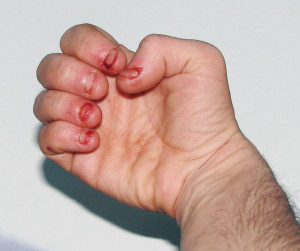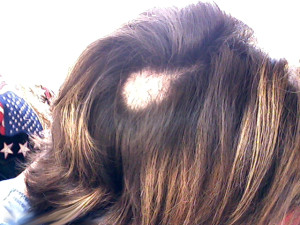This post is part of a series of guest posts on GPS by the graduate students in my Psychopathology course. As part of their work for the course, each student had to demonstrate mastery of the skill of “Educating the Public about Mental Health.” To that end, each student has to prepare two 1,000ish word posts on a particular class of mental disorders.
______________________________________________
Myths and Misconceptions of Body Focused Repetitive Behaviors by Deah Abbott
Body focused repetitive behaviors (BFRBs) are repetitive behaviors that are directed at a person’s own body. They can reach the severity of a disorder and become problematic and damaging. BFRBs include issues like trichotillomania (hair pulling disorder), excoriation (skin picking disorder), onychophagia (compulsive nail biting), and compulsive cheek or lip biting. There is no catch-all diagnosis for BFRBs. However, two BFRBs, trichotillomania and excoriation, are listed as Obsessive Compulsive Related Disorders in the most recent addition of the Diagnostic and Statistical Manual of Mental Disorders, the DSM-5. The other BFRBs, if significantly impairing, can be diagnosed as an Other Specified Obsessive Compulsive and Related Disorder.
BFRBs are more common than you might think. According to the DSM-5, trichotillomania has a lifetime prevalence of 1-2% and excoriation has a lifetime prevalence of about 1.4% in the general population. This about the same rate of the best known disorder of this DSM category, Obsessive Compulsive Disorder (OCD), which has a lifetime prevalence of 1.2% in the United States. Even though BFRBs aren’t very well-known, there is still a fair amount of misinformation floating around about them. If you think you or someone you know is struggling with a BFRB it can be difficult to sort the fact from the fiction. Luckily, with a little bit of solid scientific information it is easy to dispel both myth and ignorance.
Myth: It is not a “big deal.”
 Each of these BFRBs can cause significant emotional distress and lower self-esteem. It can be extremely demoralizing to not feel in control of your own behavior and appearance. BFRBs can also cause a number of social and physical problems. BFRBs, like trichotillomania, can lead to relationship problems, social avoidance, and a decrease in work productivity. Trichotillomania can also lead to scabbing, bleeding, and infections. Some people with trichotillomania eat the hair they pull, and this can lead to a potentially life-threatening blockage of the gastro-intestinal tract. Excoriation can cause tissue damage, visible scarring, and infections. Nail biting can lead to dental damage and tissue damage on fingers. The emotional, physical, and social impact of BFRBs can significantly reduce quality of life.
Each of these BFRBs can cause significant emotional distress and lower self-esteem. It can be extremely demoralizing to not feel in control of your own behavior and appearance. BFRBs can also cause a number of social and physical problems. BFRBs, like trichotillomania, can lead to relationship problems, social avoidance, and a decrease in work productivity. Trichotillomania can also lead to scabbing, bleeding, and infections. Some people with trichotillomania eat the hair they pull, and this can lead to a potentially life-threatening blockage of the gastro-intestinal tract. Excoriation can cause tissue damage, visible scarring, and infections. Nail biting can lead to dental damage and tissue damage on fingers. The emotional, physical, and social impact of BFRBs can significantly reduce quality of life.
Myth: It is just attention-seeking.
In actuality, many people who struggle with body focused repetitive behaviors have very little awareness of what they are doing when they engage in these behaviors. These behaviors are often done automatically. Moreover, people that engage in this behavior often go to great lengths to hide the signs and symptoms of the behavior in order to keep their problem a secret. There are fashion blogs devoted to covering up the visible symptoms of BFRBs like Trichotillomania. How a person is feeling or where they are can affect the rate in which they engage in the behavior. In a study of how the emotional states affect BFRBs, participants were more likely to engage in the behavior when alone, bored, frustrated, or stressed. These behaviors have nothing to do with trying to get attention and can actually negatively affect social interactions.
Myth: It is a choice.
As previously discussed, many people who engage in BFRBs are not fully aware of what they are doing at the time. The frequency with which they engage in the behavior can depend a lot on their emotions and what is going on around them. These things are not fully in the person’s control. Also, it appears genetics do play a role in the prevalence of BFRBs although more research needs to be done to determine the exact degree to which genetics play a factor. People with behavior focused repetitive behaviors are much more likely to have close relatives that have BFRBs or OCD. Laboratory researchers have uncovered a gene in mice that can cause behaviors related to OCD and BFRBs. This laboratory research is intriguing and may eventually help guide researchers to a better understanding of the much more complicated genetic component related to OCD and BFRBs in humans.
Myth: If a person wanted to stop they would.
 This a hurtful misconception. Many people who struggle with BFRBs go to great lengths to stop the behavior but to no avail. The testimonies in the first 50 seconds of the trailer for the documentary “Bad Hair Life” depict just a few of the ways people with trichotillomania try to stop themselves from pulling hair: wearing gloves or mittens, wearing hats or head gear, and using drastic forms of self-punishment. One of the requirements for being diagnosed with trichotillomania or excoriation is actually repeated attempts to decrease or stop the behavior. This is not an easy thing to stop doing in any way.
This a hurtful misconception. Many people who struggle with BFRBs go to great lengths to stop the behavior but to no avail. The testimonies in the first 50 seconds of the trailer for the documentary “Bad Hair Life” depict just a few of the ways people with trichotillomania try to stop themselves from pulling hair: wearing gloves or mittens, wearing hats or head gear, and using drastic forms of self-punishment. One of the requirements for being diagnosed with trichotillomania or excoriation is actually repeated attempts to decrease or stop the behavior. This is not an easy thing to stop doing in any way.
Myth: Once you’ve started, you can never stop.
While it is easy to feel hopeless after trying several things to stop, BFRBs are in no way impossible to beat. With proper treatment and support, many people are able to stop entirely. Of those who do not stop entirely, many are able to significantly decrease the frequency and severity of their behavior.
Myth: Any treatment is as good as any other.
The key is seeking out evidence-based treatments for BFRBs. Kelly Jent wrote an excellent blog post on evidence-based treatments for trichotillomania. Because the body focused repetitive behaviors have so much in common, the treatments for each of these disorders are very similar. More research has been done on the effect of treatment on trichotillomania and excoriation than the other BFRBs, but cognitive based therapies, like stimulus control, habit reversal therapy, dialectical behavior therapy, and acceptance and commitment therapy, have proven to have significant therapeutic effects on these disorders.
—-
More than likely, there are other common myths and misconceptions about BFRBs that I haven’t listed. If you struggle with a BFRB or know someone who does, are there other misconceptions you’ve encountered? If so, feel free to let us know in the comments below.
